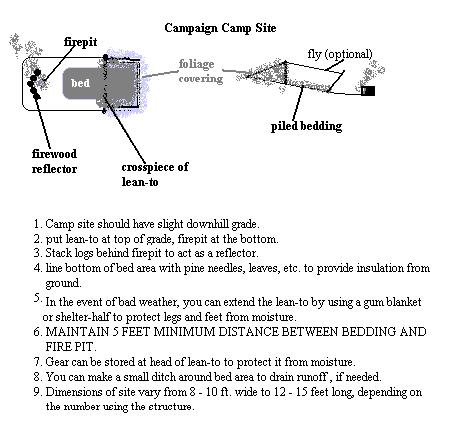
Campaigners,
take heart! You needn’t spend the whole weekend sitting in a mud puddle
because you didn’t bring your shelter-half along (unless you really want
to). You have options, but they involve teamwork and cooperation (not to
mention minty fresh breath).
What
you need are two or three like-minded pards, a large knife or camp ax,
and the time to put the plan into action (about eight man-hours). A ten
to fifteen foot length of rope would be nice, but not essential.
Begin
by clearing an area about ten feet wide by fifteen feet long. The ideal
site, described here, will have two trees or fence posts about ten feet
apart on one end of the plot. Try to set up on the lee side of a hill,
out of any obvious runoff or areas of ponding. You want to remove any large
sticks and rocks, and make sure you haven’t located the residence of any
stinging or poisonous life forms. A slight slope is better than level
ground.
Next,
you want to string your rope across the two uprights, about three and a
half to four feet above the ground. You can use a suitable length of wood
for the same purpose, but you do need the cross piece. Meanwhile, one of
your pards is off cutting down branches or other suitable foliage, about
four to five feet in length. You need a lot of these, so don’t bother the
worker bee with other tasks. He’s plenty busy.
While
you’re waiting for the shrubbery, go to the other end of the plot and prepare
your fire pit. You need a shallow depression, no more than four inches
deep. When you’re done, help your bunkies gather firewood (they should
already be doing this). Gather any dry wood you can find, preferably stuff
that has been down long enough to turn grayish. This is seasoned wood,
and will burn more easily and produce more heat than green wood. Stack
the wood on the side opposite the shelter end of your plot (i.e., behind
the fire pit.)
By
this time, there should be enough foliage in camp to begin constructing
the lean-to. The secret to making the lean-to water resistant is layering.
The first layer rests against the cross piece, and also covers the two
sides of the lean-to, leaving the side facing the fire pit open. The next
layer must overlap the first to cover as many openings as possible. The
third layer should cover any remaining holes. If needed, add a fourth or
fifth layer. If you are expecting rain, you can place a gum blanket on
top of the lean-to to provide more shelter from the elements, and
you can extend the sides and top a few feet to provide more dry area forward.
You must maintain a minimum of five feet of clear area between your fire
and your sleeping area, more if there is a wind that keeps changing direction,
so that embers and sparks from the fire do not ignite you or your weekend
palace.
For
the entire sleeping area, you will want to put about four or five inches
of dry leaves, pine needles, straw, or grass down for insulation. You will
want to do this even in summer, as it keeps the chill of the ground away.
Over this, you can place a gum blanket or a blanket, as a sort of
“mattress cover”. Now you can place the bedrolls up under the lean-to to
keep them out of the weather.
At
dusk, make your fire for the night by starting a small fire and keeping
it small. This fire will keep your feet warm, and drive away any dew that
may form. You can increase the effectiveness of the fire by standing up
pieces of wood behind the fire pit as a sort of reflector, directing the
heat toward the lean-to. It also helps keep the wind from blowing embers
about. The reflector should be no closer than two feet to the fire, and
ideally it should be further from the fire than the length of the tallest
piece of the reflector wall.
Take
a few pieces of wood and lay them up by the lean-to, to keep them out of
the weather. That way, you will have dry wood to start the fire next day.
Use your gum blankets to cover the parts of your blankets that project
beyond the cover of the shelter. The unused headspace in your shelter makes
a good place to stow gear like your muskets and such. Do not store food
in your shelter, as creatures of the night may not be concerned about disturbing
your sleep if they smell a Snickers bar or can of tuna fish.
When
the event is over, take some time to disassemble your shanty, spread things
about the site, and make certain your fire is soaked and stirred well,
and pack your trash out (Well, thank you, Ranger Rick).
Oh,
yeah, about the minty fresh breath: Could you sleep next to someone with
stale cheese breath? Didn’t think so. I mean, there’s authentic, and then
there’s just disgusting…
